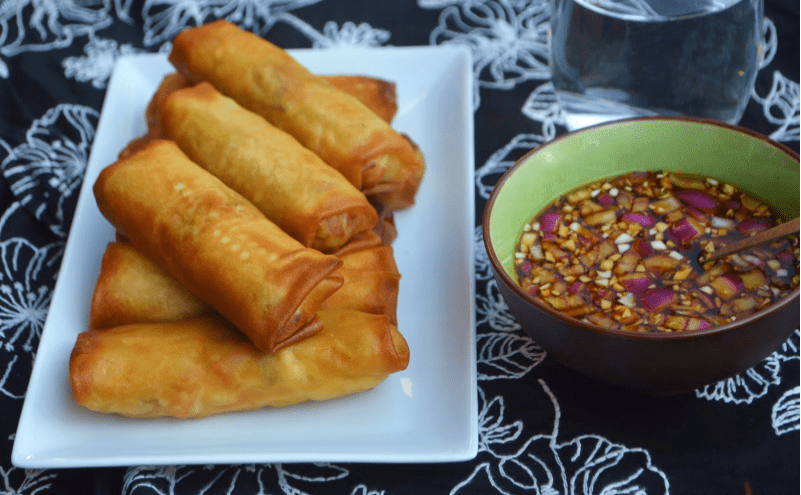What is lumpia? Lumpia is the Filipino word for spring rolls. Yes, spring rolls. And no, it is similar but not the same as Chinese or Vietnamese spring rolls.
For most Filipinos, fried lumpia is a staple viand on the table. Be it filled with ground pork meat (lumpiang shanghai), vegetables (lumpiang gulay), or bean sprouts (lumpiang togue). For me, my favorite is the lumpiang togue paired with a vinegar dipping sauce. Yum!
This fried roll is usually rolled into one-inch-thick rolls 3 to 5 inches long. I honestly cannot claim the recipe for the dipping sauce. Credit goes to Keely at Gormandize. I love the combination of sweet, salty and the slight heat of her recipe. Plus, it is easily made with a few ingredients found in any Filipino kitchen.
Lumpiang Togue
Lumpia
- 2 tbsp oil
- 1 onion, finely diced
- 4 cloves garlic, minced
- 1 small carrot, finely sliced
- 1-2 stalks celery, finely sliced ((optional))
- 1 tbsp soy sauce (or fish sauce)
- 4 cups togue (also called mung bean sprouts), cleaned
- 100-250 grams ground meat (pork, beef or chicken) ((optional. depends on how much meat you want to have) – you can substitute tofu for this)
- salt, to taste
- pepper, to taste
- 20 spring roll wrappers
- 1/4 cup water
- vegetable oil, for deep frying
Vinegar Dipping Sauce
- 1 red onion, finely chopped
- 3 cloves garlic, minced
- 1 cup vinegar
- 1/4 cup soy sauce
- 1 tsp sugar
- 1/4 tsp cracked black pepper ((2 pinches of powdered black pepper))
- 1 pinch chili flakes ((optional))
Making the Lumpia
-
Heat the 2 tbsp. oil in a wok and sauté the onion and garlic until just softened and translucent. Add the meat or tofu and cook till slightly brown. Stir. Add the carrots and a little water enough to cover the carrots. Simmer for a few minutes and then add the celery. Once the carrots are just tender (they can be just slightly undercooked), turn off the heat and add the soy sauce, and bean sprouts. The residual heat will just slightly cook them. Sprinkle your salt and pepper.
-
Cool the filling (while it’s cooling, you can make your vinegar dipping sauce)
-
Roll up the spring rolls. Make sure to drain all the liquid before placing your filling in the wrapper, or the wrapper will tear and fall apart. Use about 2 heaped tbsp. per roll. You can use a dab of water at the edge of the wrapper to help moisten and seal the wrapper before frying.
-
Once your rolls are all done, clean out the wok and then fill generously with oil. Heat the oil and then test it by throwing in a corner of spring roll wrapper – if it floats to the top and looks like it’s fizzing then your oil is hot enough.
-
Deep fry the spring rolls in batches until golden brown (if you prefer, you can shallow fry them and make sure you turn them while cooking to cook both sides). You will probably need to turn them over to cook both sides as they’ll float on the surface. Once golden brown, remove with a slotted spoon and drain on a bit of paper towel to absorb excess oil.
-
Serve hot. If you made long lumpia, then you may want to slice them in two when serving.
Preparing the sauce
-
Combine all ingredients, and mix well until sugar is completely dissolved.
Fried lumpia tastes best when hot and crispy. So cook only what you can eat, and keep the uncooked rolls in a container in the refrigerator. Uncooked, it will keep for about 3-5 days before the sprouts lose that crispness. I would not recommend freezing this as the sprouts become mushy and the crispness, once cooked, just isn’t the same.
For the sauce: This makes a lot of dipping sauce so you may want to save about half for another day. This will keep for another two weeks in the refrigerator. For those who do not like the heat, leave out the chili flakes and substitute a white onion for the red.





